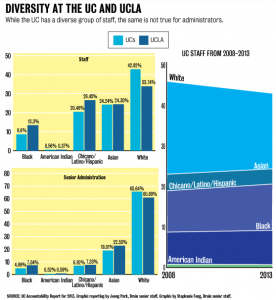 Diversity continues to be lacking at the University of California’s senior management level, even as the University seeks to improve diversity in its workforce.
Diversity continues to be lacking at the University of California’s senior management level, even as the University seeks to improve diversity in its workforce.
With minority representation in the UC workforce lagging behind the state’s and University’s demographics in recent years, some employees have voiced concerns that a lack of diversity at the highest level may hurt the University’s workforce as a whole.
Senior management staff include chancellors, directors and supervisors. In 2012, the UC had 183 full-time senior managers – 22 from UCLA – according to the 2012 Staff Workforce Profile.
During the 2012-13 academic year, close to 80 percent of senior managers at the UC were white, and about 60 percent of them were men, according to the UC Annual Accountability Report 2013.
The UC’s top administrators manage about 133,000 staff, making the University one of the largest employers in the state.
“Nothing’s ever going to be perfect, but things flow down from the top,” said Iris Williams, a staff research associate at the Department of Hematology/Oncology at the David Geffen School of Medicine and a member of the University Professional and Technical Employees union. “It’s like parents affecting their children.”
Under Proposition 209, as a research university receiving federal grants, the UC is a federal contractor that has to demonstrate it does not discriminate against minorities, females, veterans and people with disabilities. In response, each campus has an affirmative action plan for staff and faculty, addressing efforts to prevent discrimination.
Dwaine Duckett, vice president of human resources at the UC, said he thinks diversity in the administration matters for the UC because University leaders need to make decisions that reflect the diverse needs of the community they represent.
“Without diverse leaders in the room, we may not get the points of view from all around that will help us to make better decisions and become a stronger organization,” Duckett said.
Lauren Buisson, a copy cataloger in the Charles E. Young Research Library Department of Special Collections and vice-president of the UCLA chapter of the Teamsters Local 2010, which represents clerical and allied services employees, said she thinks diversity of all kinds is important in the workplace because it helps combat prejudice and bullying.
“You have people in a position of power who create an echo chamber around them, so they are reassured that their thinking is perfect,” Buisson said. “If all the people you have around you think the same way you do, you’re never going to get it right.”
Across the UC, the situation has been improving in recent years, Duckett said. Since 2009, three female chancellors and the University’s first ever woman president have joined the system.
In January, all UC campuses were required to implement a set of five measures, including appointing a lead discrimination officer to ensure incidents of discrimination are addressed fairly and transparently, according to the UC response to Moreno Report published by president Janet Napolitano.
At the campus level, UCLA hired two discrimination prevention officers recently and announced the creation of a new position of Vice Chancellor of Equity, Diversity and Inclusion.
Despite these changes, recruitment for top senior positions remains challenging.
Numerous qualification requirements, including doctorate degrees, for these high-level staff limits the candidate pool drastically, said Peter Taylor, the former chief financial officer of the UC.
Demographic changes pose additional challenges for achieving and sustaining employee diversity on campus.
In the next decade, more than one-third of UC staff will reach retirement age, according to the accountability report. As of October 2011, about 86 percent of senior management staff at the UC is above 50 years old, according to the UC InfoCenter.
Beginning in March, the UC also must meet new minimum hiring requirements for veterans and people with disabilities, which may be difficult for UCLA, said George Tejadilla, assistant director of UCLA Staff Diversity and Affirmative Action/Equal Employment Opportunity Compliance Office.
In response, UCLA is identifying nonprofits that work with veterans and people with disabilities to advertise job postings through those organizations, Tejadilla said.
Taylor, who was previously the managing director of the investment bank Barclays Capital, said he thinks the key to greater staff diversity lies in tapping a broader pool of candidates at the entry-level, so that quality entrants can grow into senior positions down the road.
“You have to get out of the paradigm of how you traditionally recruit and expand the network and processes by which recruitment occurs to improve the (staff) mix,” Taylor said.
Michael Fehr, a member of the University Professional and Technical Employees union and a UCLA computer resource specialist, said he thinks it can be difficult for the university to police issues related to diversity and equity because bias can be subtle.
Still, he thinks UCLA leaders should be more proactive in their approach, rather than responding only when high-profile discrimination incidents occur.
“The burden is on the university to come up with results,” he said. “(It has) ample opportunity and resources, and there’s a lot of people who would want to get involved.”
Contributing reports by Amanda Schallert, Bruin senior staff.